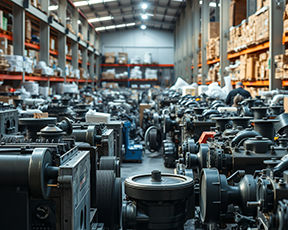Published: June 19, 2025 | Updated: October 23, 2025
Published: June 19, 2025 | Updated: October 23, 2025
Why Warehouse Logistics Are Essential for Streamlined Order Fulfillment
 Businesses need products to move. Maintenance departments need inventory. In either case, each needs to understand the importance of warehouse logistics. Unless supervisors monitor and review organization, chaos tends to sap efficiency.
Businesses need products to move. Maintenance departments need inventory. In either case, each needs to understand the importance of warehouse logistics. Unless supervisors monitor and review organization, chaos tends to sap efficiency.
In this article, we'll discuss the following topics:
- What Is Warehouse Logistics and Why It Matters.
- How Organization Reduces Costs in Warehouse Logistics.
- Common Warehouse Logistics Challenges and How to Overcome Them.
- 6 Actionable Steps to Improve Warehouse Order and Flow.
- Using CMMS Software to Support Warehouse Logistics.
What Is Warehouse Logistics and Why It Matters
Warehouse logistics encompasses the strategic management of all activities within a warehouse. It involves optimizing the flow of goods.
It starts with receiving. Actually, you can step back even further and say it begins with purchasing. Knowing what and how much you'll buy to put into the warehouse.
From there, you'll process and store. Later, you'll move those products for shipping or use in the company. Everything takes planning, effective and efficient space utilization, and the strategic implementation of technology.
Let's look at four areas to consider.
- Inventory management. Tracking stock levels, designating storage locations, and forecasting demand. The goal—to prevent stockouts or overstocking.
- Warehouse layout design. The goal—to create a layout that facilitates efficient movement of goods, and picking processes, and minimizes travel time.
- Warehouse automation. Implementing technology like conveyor belts, sorting robots, and warehouse management systems (WMS). The goal—to automate tasks and improve accuracy.
- Order fulfillment. Picking, packing, and shipping orders accurately and efficiently. Goal—to meet customer delivery expectations.
How Organization Reduces Costs in Warehouse Logistics
A disorganized warehouse can hemorrhage money. Hidden costs come through poor layouts, inefficient picking routes, and misplaced inventory. However, with proper warehouse management, companies experience the following benefits.
- Reduced labor costs. Optimized picking routes and minimized travel time for workers show efficiency and less "stress" for employees.
- Lower Inventory Holding Costs. Efficient space utilization allows for better inventory oversight. You don't have clutter or items piled up in corners.
- Reduced energy costs. Because of an efficient layout, you can turn off lights in certain areas. Adjust thermostats for temperature controls. If you pay by floor usage, you'll see a decrease in that expense if you use less floor space.
- Improved Picking Accuracy. Clear labeling and designated storage locations minimize picking errors. These result in fewer returns, reorders, and more customer satisfaction.
- Faster Order Fulfillment. This makes sense if you have all of the above points. The fulfillment part of the operation improves. You may even beat customer expectations.
For further details concerning cost-savings, read the article at Canon.
Where else will you see benefits? Read on for the following that go beyond cost factors.
- Enhanced Customer Satisfaction. Faster order fulfillment and fewer errors lead to happier customers. You instill loyal customers who spread the good word. This improves brand reputation.
- Increased Inventory Turnover. Improved inventory management helps maintain consistent stock levels. You maintain proper quantities and reduce the risk of stockout.
- Improved Safety. De-cluttered floors and shelves. Proper weight distribution of products in storage. Clean floors and walkways.
- Scalability for Growth. Utilizing efficient floor space gives the company room to grow. With clutter, you tend to make more clutter as you add items.
Common Warehouse Logistics Challenges and How to Overcome Them
As you'll read later, planning brings up potential obstacles for you to overcome. Knowing them before you begin saves time and money. Challenges offer options and ways to improve operations. Let's review a few issues you might encounter.
- Rapidly Changing Inventory. E-commerce and dynamic customer demands necessitate constant adjustments to warehouse layouts and picking strategies. This means you have to continually review floor space usage and location assignments.
- Space Constraints. Some companies have limited warehouse space. This means you have to refine your plans for the best operations. Consider special projects for warehouse expansion or renting further space.
- Employee Training. Maintaining organization requires ongoing training for new employees on proper picking, packing, and inventory management techniques.
- Data Management and Visibility. For accuracy and purchasing, you need real-time inventory data. Always maintain clear communication between departments. You must have a solid foundation before building the tenets of organization.
Discover how streamlined maintenance processes can elevate production. Learn more.
6 Actionable Steps to Improve Warehouse Order and Flow
Transforming your warehouse into a symphony of streamlined processes doesn't happen overnight. Following ordered steps takes discussion and may involve small adjustments so everyone stays on the same page.
- Planning. Even if you have years of experience but see needed changes, plan out the goals. Meet with both workers and management for suggestions. Within the plan, forecast any obstacles as mentioned above. Weigh options for solutions.
- Warehouse Layout Redesign. Part of the plan may involve analyzing your current layout. Identify areas for improvement. Consider implementing strategic zoning based on product size, weight, and demand.
- Implement a Warehouse Management System (WMS). This system helps automate processes, track inventory in real time, and optimize picking routes.
- Standardization and Labeling. Consistency in labeling and labeling procedures. Company standard product identification, location codes, and expiration dates.
- First-In, First-Out (FIFO) Inventory Management. This prevents older stock from expiring or becoming obsolete while ensuring you use fresh stock first. For more information on FIFO read an article at Identec Solutions.
- Continuous Improvement: Once you have a plan in place, don't forget to regularly review it. Keep communications open between employees for areas of improvement.
Industry Examples of Proper Warehouse Logistics
Let's look at various industries where the importance of warehouse logistics plays a huge role.
- Retail needs efficient order picking and fulfillment for timely delivery to stores and online customers.
- Manufacturing needs organized warehouses. They must maintain a steady flow of raw materials and finished products and prevent production disruptions.
- Food & Beverage producers must watch stock rotation and temperature control in the warehouse.
- Pharmaceuticals: Strict regulations and temperature control necessitate a highly organized warehouse for pharmaceuticals for product integrity and to prevent spoilage.
Image description: A warehouse worker uses a CMMS to improve warehouse logistics
Using CMMS Software to Support Warehouse Logistics
How can CMMS software play a vital role in maintaining warehouse organization?

- Preventive Maintenance (PM). Keeping conveyors, packing equipment, and other assets running. A list of PMs and their cycles helps keep assets reliable, extends their lifespan, and minimizes downtime. PMs help find issues before they evolve into serious problems.
- Inventory Management. If you operate in a company that has a stockroom, the CMMS keeps this place organized. Similar to a warehouse. Assigning locations for parts and tracking quantities. Keeping track of a list of which equipment uses which parts.
- Work Order Management. CMMS facilitates the creation and tracking of work requests and work orders for equipment repairs and PMs. Assigning types and priorities helps technicians' efficiency.
- Key Performance Indicators (KPI). The system provides valuable data on equipment performance. It will track depreciation values and equipment readings. These reports and numbers help shape maintenance operations.
Strong Warehouse Logistics Drive Business Success
Do not underestimate the importance of warehouse logistics. You must embrace organization for efficiency to thrive.
This requires ongoing commitment, employee training, and the strategic implementation of tools like WMS and CMMS. Remember, a well-organized warehouse does not consist of just a tidy space. It encompasses people, communications, and commitment.
To understand how a CMMS adds value to your operations, call 800-922-4336. Ask a Mapcon Technologies representative for a free demonstration. You work hard. MAPCON helps you work smarter.
FAQs
What are the core components of warehouse logistics?
Warehouse logistics involve the strategic management of all in-warehouse activities, including inventory management, layout design, automation, and order fulfillment.
How does an organized warehouse reduce a company's costs?
A well-managed warehouse reduces costs by optimizing labor efficiency, lowering inventory holding expenses, and minimizing errors to improve picking accuracy and reduce returns.
What are some common challenges in managing warehouse logistics?
Key challenges include adapting to rapidly changing inventory and customer demands, overcoming space constraints, and ensuring effective employee training and real-time data visibility.
What role does a CMMS play in supporting warehouse efficiency?
A computerized maintenance management system (CMMS) ensures that critical assets like conveyors and packing equipment run reliably through Preventive Maintenance (PM) and Work Order Management.
How can CMMS software from MAPCON assist with maintenance inventory?
The CMMS from MAPCON helps organize the maintenance stockroom by assigning locations for parts, tracking quantities, and recording which equipment uses specific spare parts.
What are two actionable steps for a business to improve warehouse flow?
Two crucial steps are implementing a Warehouse Management System (WMS) for real-time tracking and optimization, and enforcing Standardization and Labeling consistency across the facility.
MAPCON CMMS software empowers you to plan and execute PM tasks flawlessly, thanks to its wealth of features and customizable options. Want to see it for yourself? Click the button below to get your FREE 30-day trial of MAPCON!
Try It FREE!